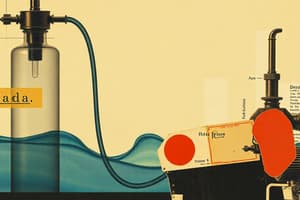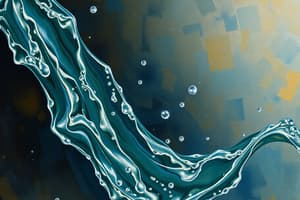Podcast
Questions and Answers
What is the primary purpose of a pressure gauge?
What is the primary purpose of a pressure gauge?
- To display the flow rate of liquids
- To measure the volume of fluid in a system
- To determine temperature changes in fluids
- To measure and display pressure (correct)
Which type of pressure measurement device utilizes a column of liquid to measure pressure differences?
Which type of pressure measurement device utilizes a column of liquid to measure pressure differences?
- Vacuum gauge
- Pressure sensor
- Manometer (correct)
- Bourdon gauge
Which of the following statements about calibration of pressure measurement devices is true?
Which of the following statements about calibration of pressure measurement devices is true?
- Frequent calibration is required to ensure accuracy (correct)
- Pressure sensors do not need to be calibrated
- All devices are calibrated only once at installation
- Calibration is not necessary for vacuum gauges
What principle is commonly illustrated by the operation of a Bourdon gauge?
What principle is commonly illustrated by the operation of a Bourdon gauge?
What is a key advantage of using pressure sensors in modern technology?
What is a key advantage of using pressure sensors in modern technology?
What is the main application of Pascal's Law in hydraulic systems?
What is the main application of Pascal's Law in hydraulic systems?
In which scenario is Bernoulli's Principle most applicable?
In which scenario is Bernoulli's Principle most applicable?
How does hydrostatic pressure change as depth in a fluid increases?
How does hydrostatic pressure change as depth in a fluid increases?
Which unit is commonly used to measure fluid pressure?
Which unit is commonly used to measure fluid pressure?
What effect does an increase in fluid speed have on pressure, according to Bernoulli's Principle?
What effect does an increase in fluid speed have on pressure, according to Bernoulli's Principle?
Which of the following best explains buoyancy?
Which of the following best explains buoyancy?
What role does fluid pressure play in blood circulation?
What role does fluid pressure play in blood circulation?
What happens to the pressure in a plumbing system as water flows through pipes?
What happens to the pressure in a plumbing system as water flows through pipes?
Flashcards
Hull of a boat
Hull of a boat
Part of the boat that withstands water pressure.
Pressure gauges
Pressure gauges
Devices that measure and show pressure.
Manometer
Manometer
Measures pressure using liquid column.
Bourdon gauge
Bourdon gauge
Signup and view all the flashcards
Pressure sensor
Pressure sensor
Signup and view all the flashcards
Fluid Pressure
Fluid Pressure
Signup and view all the flashcards
Pascal's Law
Pascal's Law
Signup and view all the flashcards
Hydrostatic Pressure
Hydrostatic Pressure
Signup and view all the flashcards
Bernoulli's Principle
Bernoulli's Principle
Signup and view all the flashcards
Hydraulic Systems
Hydraulic Systems
Signup and view all the flashcards
Blood Circulation
Blood Circulation
Signup and view all the flashcards
Airplane Lift
Airplane Lift
Signup and view all the flashcards
Buoyancy
Buoyancy
Signup and view all the flashcards
Study Notes
Pressure in Fluids
- Fluid pressure is the force exerted by a fluid per unit area.
- Fluids include liquids and gases.
- Pressure is a scalar quantity, meaning it has only magnitude and no direction.
- Pressure is measured in Pascals (Pa), or other units like pounds per square inch (psi).
- Pressure increases with depth in a fluid.
Pascal's Law
- Pascal's Law states that pressure applied to a confined fluid is transmitted equally and undiminished in all directions throughout the fluid.
- This applies to both liquids and gases.
- A small force applied to a small area can create a large force on a larger area.
Hydrostatic Pressure
- Hydrostatic pressure is the pressure exerted by a fluid at rest due to the force of gravity.
- It is directly proportional to the depth of the fluid and the density of the fluid.
- The formula for hydrostatic pressure is: Pressure = density * gravity * depth.
Bernoulli's Principle
- Bernoulli's principle describes the relationship between the pressure and speed of a fluid.
- It states that an increase in the speed of a fluid occurs simultaneously with a decrease in pressure or a decrease in the fluid's potential energy.
- This principle is most applicable to fluids in motion.
Applications of Fluid Pressure
- Hydraulic systems: These use Pascal's Law, transmitting pressure from a small piston to a larger one, creating a mechanical advantage. Examples include car brakes, hydraulic lifts, and excavators.
- Blood circulation: The heart pumps blood, generating pressure to move it throughout the body. Pressure differences are crucial for efficient blood flow.
- Airplane flight: Differences in air pressure above and below the wings create lift, enabling flight. The curved shape of airplane wings influences the airspeed and pressure distribution.
- Buoyancy: This is the upward force exerted on an object immersed in a fluid, caused by the difference in pressure exerted on the top and bottom of the object. Archimedes' principle explains this concept.
- Plumbing systems: Water pressure is critical for delivering water to homes and buildings. Pressure differences between various points in a pipe system are crucial.
- Diving and Scuba diving: Hydrostatic pressure increases significantly with depth, affecting body systems and equipment functionality. Submersed objects experience pressure from all directions.
- Ships and boats: The hull of a boat is designed to withstand the pressure of the water it is afloat in.
Pressure Measurement Techniques
- Pressure gauges: These devices measure and display pressure.
- Manometers: Utilizes a column of liquid to measure pressure differences. A common example is a U-tube manometer.
- Bourdon gauges: Measures pressure by using a curved tube that the pressure flattens. The curvature change is converted into a mechanical reading.
- Vacuum gauges: Measure the difference between atmospheric pressure and a lower pressure.
- Pressure sensors: These are electronic devices that convert pressure into an electrical signal. Modern technology often relies on pressure sensors for automation and monitoring.
- Calibration: Accuracy is critical in pressure measurements; devices are calibrated frequently to ensure reliable values.
Studying That Suits You
Use AI to generate personalized quizzes and flashcards to suit your learning preferences.




